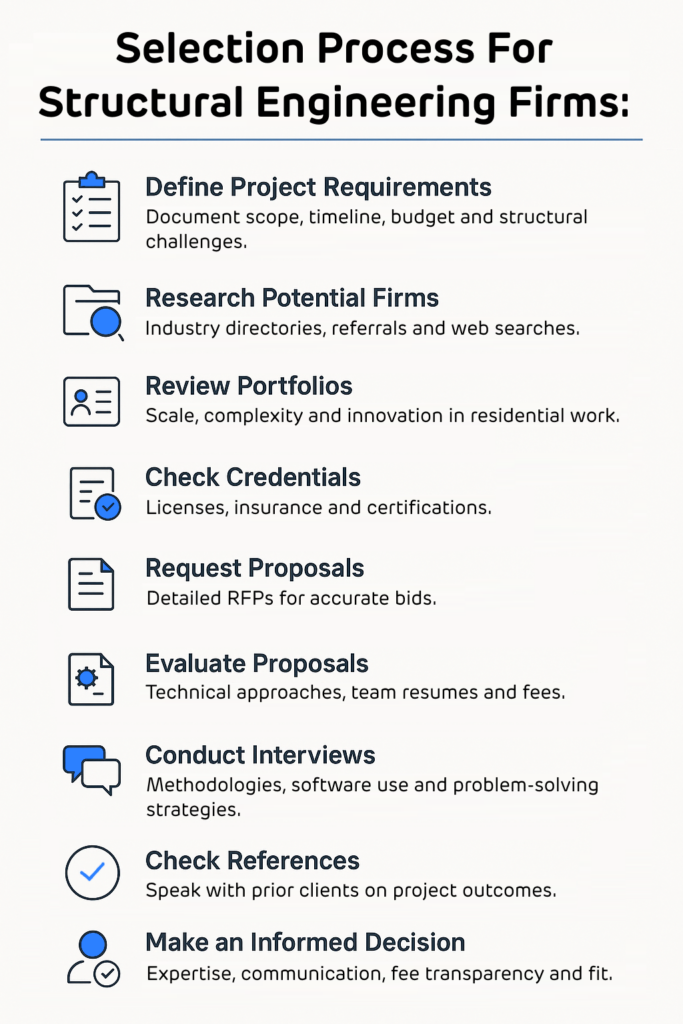Introduction
Structural engineering ensures residential towers and multi-family complexes are safe under gravity, wind, seismic and live loads – failure is catastrophic and liability. Thorough analysis and design mitigates deflection, cracking or collapse, and preserves occupant safety and asset longevity. Complex residential buildings – high-rise condos, large housing clusters or architecturally unique structures – require specialized firms that can handle advanced materials and engineering design , irregular geometries and challenging site conditions. Choose the wrong firm and you’ll get structural defects, rework, schedule overruns and reputational damage.
Key Evaluation Criteria for Structural Engineering Firms
Experience and Expertise
Proven Track Record with Similar Projects
Review portfolios for residential construction projects of similar scale and complexity. For example, firms that have experience with tall concrete and steel structures, wind-resistant systems and advanced health-monitoring integration. Explore completed structural projects for residential buildings, see real‑world examples and vendor portfolios.
Depth and Breadth of Expertise within the Team
Make sure the firm has licensed engineers with specialties in high-rise design, seismic resilience or wind engineering. Their continuous professional development – ASCE certifications or seismic engineering programs – shows commitment to staying current.
Understanding of Architectural Intent
Experienced firms work seamlessly with architects, translating design intent into framing systems. Look for case studies where structural solutions preserved unique facades or cantilevered elements without compromising integrity.
Technical Capabilities and Software Proficiency
Advanced Structural Analysis and Design Software
Leading firms use cutting-edge technology like SAP2000, ETABS and STAAD.Pro for linear, non-linear, dynamic and finite element analysis for load modeling.
BIM (Building Information Modeling) Expertise
BIM (Revit, ArchiCAD) enables clash detection, quantity takeoffs and real-time model updates. Research shows BIM adoption in residential projects reduces RFIs by over 30% and accelerates coordination. Prestigious projects like Circus West at Battersea used Revit to manage 752 apartments across a 17-storey podium, streamlining documentation and collaboration. Get BIM Services by expert vendors on BuildTwin Marketplace.
CAD and Drafting Capabilities
Precise 2D/3D CAD drafting (AutoCAD, MicroStation) underpins all shop drawings and construction documents. Effective workflows turn design development sets into contractor-ready plans, minimizing errors and change orders. Translate your design into fabrication‑ready plans, leverage BuildTwin’s CAD and drafting specialist vendor network.
Understanding of Building Codes and Standards
Comprehensive Knowledge of Relevant Codes
Top firms stay current with IBC, ASCE 7, ACI and AISC standards plus local amendments. This means all staff meet strength and serviceability requirements.
Experience with Code Compliance for Complex Structures
They navigate special inspections, permit process and liaise with authorities efficiently – a critical advantage when building under tight regulatory scrutiny.
Detailing Capabilities of Structural Engineering Design
Steel Detailing Expertise
Look for firms that produce fabrication-grade shop drawings via Tekla or SDS/2, complete with connection weld-and-bolt patterns and erection sequences.
Precast Detailing Expertise
Precast specialists deliver reinforcement layouts, lifting-point specifications and joint details to support off-site concrete panel production. Streamline your off‑site workflows, get precast detailing services from pre-vetted vendors:
Rebar Detailing Expertise
Precision in bar bending schedules and 3D reinforcement models ensures accurate cutting, minimizes waste and re-work on site.

Communication and Collaboration
Effective Communication Skills
The chosen firm should explain complex analysis in plain English, be transparent with clients, architects and contractors.
Collaborative Approach
They proactively resolve design conflicts, have regular coordination meetings and update BIM models as the project evolves.
Responsiveness and Availability
Timely responses to RFIs, flexible meeting schedules and site visit support are key to keeping tight construction timelines on track.
Seamless coordination and real‑time tracking on your residential building structural engineering project, explore how BuildTwin helps you.
Reputation and References
Positive Client Testimonials and Reviews
Get firsthand feedback on the firm’s services, reliability, quality of deliverables and professionalism.
Industry Recognition and Awards
Awards from CTBUH, AISC or ASCE show firms that push innovation in structural engineering.
References from Architects and Contractors
Peer recommendations often reveal insights into a firm’s teamwork and integrity on complex projects.
Cost and Value
Transparent Fee Structure
A clear proposal outlines lump-sum vs. hourly rates, deliverable milestones and reimbursable expenses.
Value for Money
Evaluate the level of expertise and risk management relative to fees – lowest bid isn’t always best when life-safety is on the line.
Sustainability and Resilience Considerations
Understanding of Sustainable Design Principles
Experience with low-carbon materials, thermal-bridge mitigation and LEED or Passive House standards sets leading firms apart.
Focus on Resilience
Ensure the firm designs for site-specific hazards – earthquake, hurricane, flood – to safeguard occupants over the building’s lifecycle.
The Selection Process For Structural Engineering Firms
Step-by-Step Guide for Clients
- Define Project Requirements: Document scope, timeline, budget, and unique structural challenges.
- Research Potential Firms: Use industry directories, online searches, and referrals from trusted sources.
- Review Portfolios and Case Studies: Focus on projects with similar scale, complexity, and structural systems.
- Verify Credentials: Confirm licenses, professional registrations, and insurance coverage.
- Request Proposals: Provide detailed project information for accurate technical and fee estimates.
- Evaluate Proposals: Compare technical approach, team qualifications, deliverables, and cost breakdowns.
- Conduct Interviews: Meet key engineering personnel, discuss methodologies, and assess communication style.
- Check References: Contact past clients and project partners to gauge performance, reliability, and collaboration.
- Make an Informed Decision: Select the firm that best aligns expertise, values, and budget considerations.

Questions to Ask Potential Vendors
- What similar complex residential projects have you done?
- Which structural analysis and BIM software do you use?
- How do you handle code compliance and inspections?
- Describe your steel, precast and rebar detailing workflows.
- How do you manage design changes and RFIs?
- Can you share client references and testimonials?
Red Flags to Watch Out For
- No high-rise or multi-family experience.
- Vague proposals without clear deliverables.
- Won’t share references or past case studies.
- Poor communication or unresponsiveness.
- Fees much lower than market rate.
- No BIM or advanced software usage.
Explore how BuildTwin helps you with your Residential Building engineering project.

Top Structural Engineering Firms for Residential Building Structural Engineering
Below are eight leading firms excelling in residential structural engineering, listed with key details and notable projects.
Durchgeplant
- HQ & Scale: German firm with 50+ engineers in Giessen and Frankfurt.
- Expertise: Digital precast workflows, 3D BIM modeling, agile Scrum‑based project management, and cast‑in‑situ design
- Residential Projects: THE FOUR RT1 and RT4 towers in Frankfurt; Production Hall in Freiburg.
J&F
- HQ & Scale: Global footprint with 400+ engineers and detailers in six regions.
- Expertise: End‑to‑end BIM modeling, structural and MEP design, QS/BoQ services, and AI‑driven project management.
- Residential Projects: Modular dormitory in Hamburg; high‑rise renovation for Rocket Internet in Berlin
GBC Engineers
- HQ & Scale: German‑Vietnamese consultancy with 200+ staff across four offices.
- Expertise: Precast and in‑situ concrete detailing, transport and data‑center structures, and residential high‑rise engineering.
- Residential Project: The Sun Avenue Residence, eight‑tower complex in Ho Chi Minh City, Vietnam.
Arup
- HQ & Scale: Headquartered in London, Arup employs ~17,000 staff across 94 offices worldwide.
- Expertise: Offers structural engineering, sustainability consulting, digital tools (InForm), and building performance engineering for residential schemes.
- Notable Residential Projects: HAUT, a 21‑storey timber‑hybrid tower in Amsterdam; modular housing pilot schemes in the UK.
WSP
- HQ & Scale: With 67,000 professionals in over 500 offices, WSP Building Structures serves global residential markets.
- Expertise: Delivers structural design, BIM integration, MEP coordination, and modern methods of construction for apartment towers and mixed‑use residences.
- Notable Residential Projects: 432 Park Avenue, New York; Złota 44, Warsaw; South Quay Plaza, London.
Thornton Tomasetti
- HQ & Scale: Based in New York with 1,500+ engineers operating in 50+ countries.
- Expertise: Advanced analysis (seismic, finite‑element), resilience engineering, interoperability and visualization tools for high‑rise residences.
- Notable Residential Projects: The Edison, future world’s tallest timber tower in Milwaukee; The Park at Ward Village, Honolulu.
Buro Happold
- HQ & Scale: UK‑based consultancy with 1,900+ employees across 26 global locations.
- Expertise: Integrated structural, facade, MEP and sustainability services for residential high‑rise and modular buildings.
- Notable Residential Project: The House at Cornell Tech, the world’s tallest Passive House tower in New York.
Mott MacDonald
- HQ & Scale: Employee‑owned consultancy with 20,000+ staff in over 200 offices worldwide.
- Expertise: Sustainable design, advanced structural software (Robot, ETABS), and building performance engineering for residential complexes.
- Notable Residential Works: Luxury mixed‑use towers in Abu Dhabi; Seascape high‑rise in Wellington, New Zealand.
Conclusion
A thorough selection process, based on technical due diligence and clear communication, means you partner with a structural engineering firm that delivers on safety, quality and value. By evaluating experience, software expertise, detailing capabilities and sustainability credentials you get a trusted partner to bring your residential vision to life – on time, on budget and built to last. Ready to partner with vetted engineering firms and streamline every phase of structural designing, book a personalized consultation with BuildTwin.



